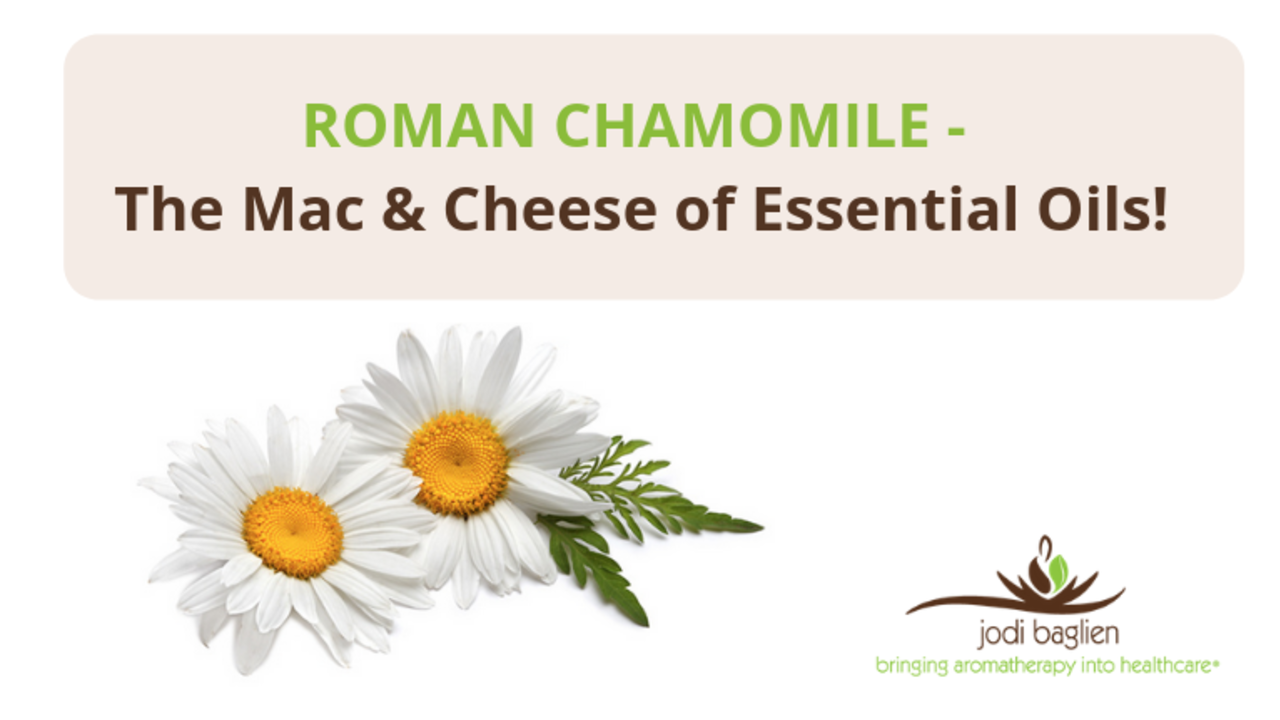Roman Chamomile - The Mac and Cheese of Essential Oils

When I think of Roman Chamomile and the gifts this gentle giant of essential oils can deliver, it's like Mac and Cheese to me.
What??
My sensory perceptions and practitioner experiences with Roman Chamomile sum it up like this. It delivers comfort like the way a yummy home cooked meal and a snuggly blanket makes you feel.
Roman Chamomile is soothing to the soul, and allows a sunnier disposition to emerge!
Let me show you a few of its therapeutic actions and uses for the body, and it's gifts with moods and emotions, and nurturing the soul.
The Basics
First, we must identify the specific plant by its botanical name – Chamaemelum nobile, it may also be identified using its botanical synonym Anthemis nobilis. Derived from the Greek word Chamaimelon, Chamai meaning on the ground, and melon, meaning apple. The flower looks similar to a daisy and has a fern-like leaves. This chamomile is primarily is native to western Europe and now primarily grown in England, Belgium, France, and Hungary
Depending on your sources, you might find the common names used, for example, English Chamomile, Camomile, and Chamomile romaine.
Also, it should never be confused with German Chamomile, or Moroccan Chamomile, which are completely different plants!
Aromatherapists typically call it Roman Chamomile. The flowering tops are steam distilled, are high in a chemical compound called Esters known for their calming effects, and the aroma is often described as “sweet, herbaceous, honey-apple like”.
Primary therapeutic actions:
Analgesic, anti-inflammatory, anti-septic, anti-spasmodic to smooth muscle tissue, digestive, febrifuge, sedative, vulnerary.
Most common uses for the physical body include:
- Skin care for sensitive, or inflamed skin, eczema, rashes, burns, and abrasions
- Supports overall relaxation to help with sleep and rest
- PMS for cramps and mood imbalances, general muscle spasms, tension headaches
- Reducing fever
- Digestive complaints that involve spasms, dyspepsia
- Gentle enough for babies with colic, teething, children with anxiety, sleep or restlessness
Most common uses for emotional and mood support:
- Anger, anxiety, frustration, and other “inflamed” emotions.
- Grief and sadness
- Calming and sedative, built up tension- especially involving a tightness around the solar plexus, and unexpressed feelings
Most common uses for spiritual and energetic care:
- Peaceful, harmonizing and balancing
- For wounds of the heart
- Grieving
- Promotes the free flow of “Qi”. Help move stuck energy.
My experience with Roman Chamomile has taught me that it is also a great teacher of patience.
When we are using oils within the “smell” framework, I have seen this oil evoke a variety of surprising responses. I vividly remember the first impressions of one particular class I was teaching.
During a “smell r cise”, an exercise where we learn about an oils aroma information, by being present and listening to the oil, the majority of the class of 25 students negatively reacted.
I mean they DID NOT LIKE it - at first.
For those who so negatively reacted, I asked them to explore their feelings and emotional responses, and consider why, and identify what was coming up emotionally.
Trust what the Aroma points you too!
They noticed feelings of their own impatience, frustration, and anger. Once they recognized this, they could ultimately let that go, they felt more relaxed, balanced and in tune.
Later when they smelled the aroma again, they found the aroma was now softer, more interesting and they were much less reactive this time.
It was such an important lesson in “experiencing the oils” for themselves and exploring what comes up. This exercise is perfect to show how each person will have their own unique interaction and response to essential oils. When it comes to how we will respond emotionally, it's not what the book says it will do, its how YOU respond. And that’s OK!!!
Practical Wisdom Tips
Whenever you are meeting a new essential oil, go slow. Say hello first, and gently wave the aroma under your nose. I chuckle watching people take a deep snort and then find they don't' like it!
If you are on the more sensitive side, dilute the essential oil (EO) first to 5%, instead of smelling at full strength.
How do you dilute? Put 5 drops of the essential oil into 1 tsp. of carrier oil. Now you have a 5% dilution! For emotional and spiritual uses that is plenty strong!
Diluting does not degrade the oil itself, or its effects. It will simply allow the aroma to open and not be so overwhelming to your senses.
Blending
One reason to mix EO's together is if you don't like the aroma but its therapeutic actions are a great fit. Select a "supporting" oil with similar actions to blend it with. For example, mix Chamomile with Lavender in equal parts for a sleepytime bath blend, or to use in the diffuser at night. Roman Chamomile also blends well with geranium, citrus oils, and clary sage.
Final Thoughts
Feel, smell, and experience your oils. Get to know them and how you respond to them.
If you are caring for others with oils, allow them the space to have their own experience without being TOLD what it will do. Nothing wrong with providing encouragement toward the goal, but look for what is happening, how they are responding. It will be, what it is.
That is part of the magic.
Stay connected with us for updates, success stories, and Aromatherapy musings!
Be a part of the culture shift - receive information about Aromatherapy in healthcare.
Don't worry, we don't send too much and your information will not be shared.
50% Complete
Two Step
Lorem ipsum dolor sit amet, consectetur adipiscing elit, sed do eiusmod tempor incididunt ut labore et dolore magna aliqua.
